Danny Kennedy, CEO of New Energy Nexus, takes a look at some of the trends that will shape the clean energy innovation space, and how New Energy Nexus is positioned to accelerate startups around the world in 2023.
2022 was a turning point in the clean energy transition, but 2023 will be the year it all takes off in earnest, which is incredibly exciting if you’re a clean energy innovator. As much wind and solar as has been built in all of history to date will be added in the next 5 years! More than 85% of all additions to the global electricity grid will be renewable this year. This means almost no more fossil power plants except in edge cases like some areas of China dependent on coal or maybe Ukraine where they’ll have to rebuild fast from Russian attacks on their infrastructure. And this is only the beginning.
All this scale will further reduce the cost of wind and solar, especially photovoltaics: the virtuous spiral will progress as renewables become cheaper still and displace not just new fossil fuel power plant proposals they compete with, but even existing fossil plants on the grid.
This is what some economists call “the great stranding” of assets, which may accelerate in 2023. It will also lead to spillovers into the “electrification of everything” and synergies with e-mobility in particular, as batteries on wheels become assets in an increasingly renewably-powered grid.
This process had been happening in the coal sector for some years. In India, with its growing population and economy, no new coal plants were financed in 2021 and many existing ones were bankrupt or operating below 50% capacity. It’s also part of the reason the oil industry has seen no growth since 2019, when a peak of production occurred at 100 million barrels per day.
Last year, the gas industry’s forecast for growth also went flat, into a long plateau of production at the same level, never to grow much again. This may seem counterintuitive with the hype around prices of oil barrels or gas BTUs on spot markets but all that volatility adds to this dynamic. That “news” is really just “noise” and the signal is clear: no-growth for fossil fuels!
Our partners at RMI have modeled this plateau and decline phase for fossil fuels in this study.
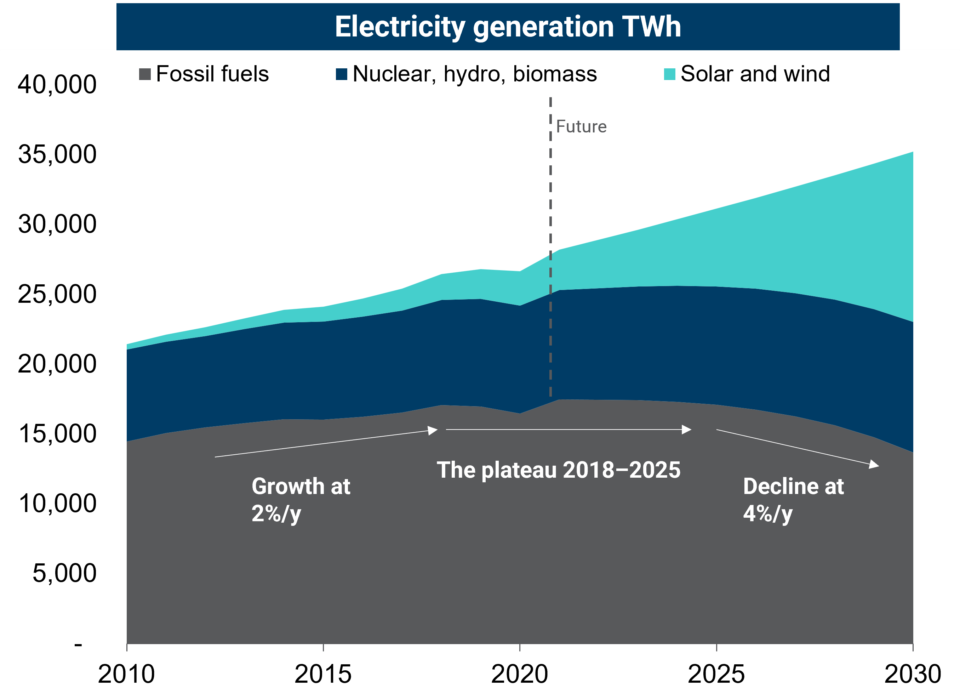
Compare this to the crazy trajectories of growth for winning technologies in clean energy. EVs crossed 10% of market share for new cars in the world last year (ICE car sales crashed 23%). EVs are up from 5% about 3 years ago – a rate of doubling that will see 100% of new cars electric by 2035 (do the maths – 10% goes to 20% in 2025; 20% to 40% in 2028; 80% in 2031; 100% in a year soon thereafter). Growth in solar is just nuts (see to your right)!
Next end-use technologies such as heat pumps – to electrify the heating and cooling of buildings – and electric appliances of all kinds will also go through exponential adoption curves displacing dirty, gas-based alternatives. In America, heat pump sales exceeded gas furnace sales for the first time last year. The number of heat pumps sold in Europe in 2022 exceeded 3 million, twice what was sold in 2019. That is another impressive rate of doubling.
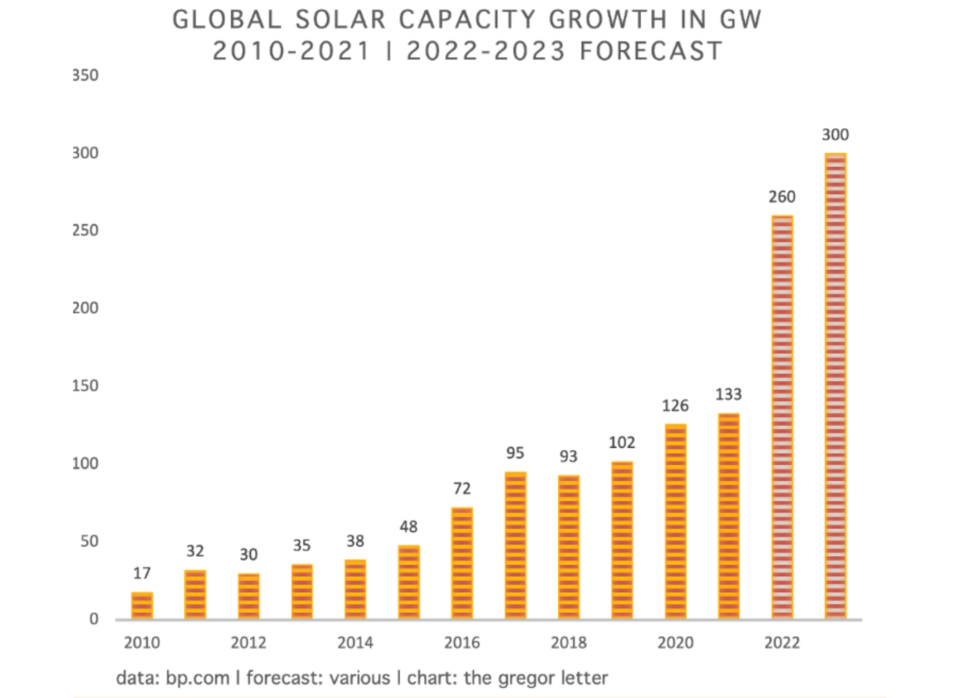
As we turn the corner and see the end of fossil fuels in our global economic system in less than 20 years or so, countries will start to compete more seriously for a lead in the export industries of our near future. These are mostly wind, solar and battery related. Other technologies are interesting on the margins, but the lion’s share of energy systems will be electric – running on solar and wind power, which will be stored mostly in Lithium ion batteries for the near term. Metals in storage technologies – aka critical materials – are key.
Countries dependent on fossil fuel exports face a world of pain, and soon.
China is crushing it in this contest. It has little to no fossil fuel exports. It leads the wind industry; the solar cell, panel, and installation business; the battery materials supply and manufacturing chain; and the electric vehicle industry, which is the main offtake of batteries for now.
America with its Inflation Reduction Act in 2022 and the EU with its Green Industrial Plan announced at the World Economic Forum in January, following its Green Deal package from 2021, are seeking to catch up. India also wants a place in the race. And other countries ranging from Australia as a raw material and renewable energy superpower to South Korea want to compete, too..
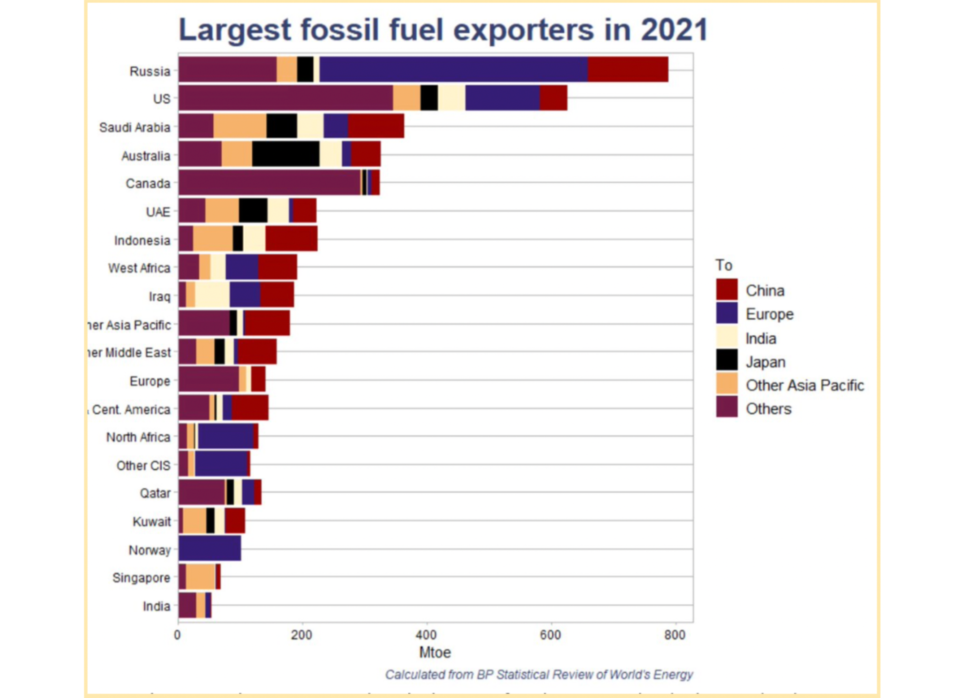
The batteries we will need to store all that sunlight for when it isn’t shining or that wind for when it doesn’t blow require a lot of mined materials. The good news is the amount is finite and the material is metal, so it can be fully recycled. As opposed to fossil fuels, which require an infinite number of mines, wells and frack sites, the new energy economy will need a limited number of mines to provision all the metal needed to run our economy on wind and solar power.
The other paradox is that all these positive trends belie a stark truth. The money isn’t flowing as freely as it should be. An increase of at least 590% – or US$4.5 to US$5 trillion – in annual climate finance is required to meet the 2030 climate goals and avoid the worst impacts of climate change.
We are nowhere near there. And what’s more concerning is that funding is not going towards the sectors and geographies that matter most, in terms of projected energy consumption and climate impacts. Africa, South Asia and Southeast Asia are missing out on the lion’s share of public and private investment (and philanthropic funding) in clean energy.
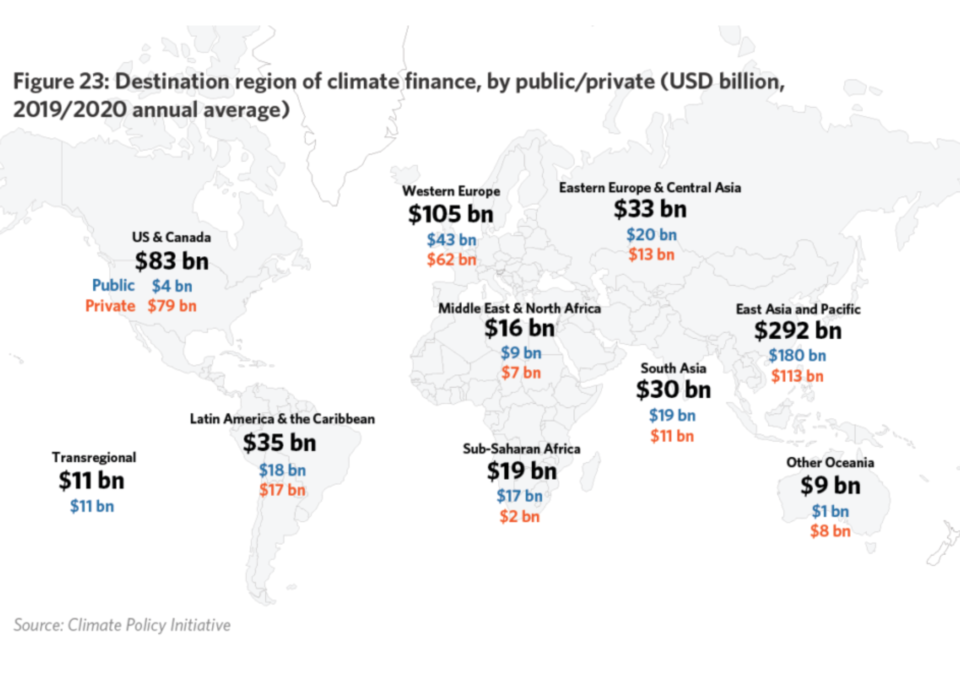
Our work of finding, funding, and training the entrepreneurs and founding teams of the companies that will run this next phase of the marathon has never been more critical.
We must improve on the deployment of technologies that are winning the race, so they can achieve their potential ASAP. A “Personal Best” for wind and solar adoption, if you like, is what the world needs, especially in markets where energy demand growth is the greatest. These are the emerging markets of Asia and Africa rather than the declining markets for energy demand growth like Europe, the USA, and Japan. Even China will peak and decline its emissions this decade.
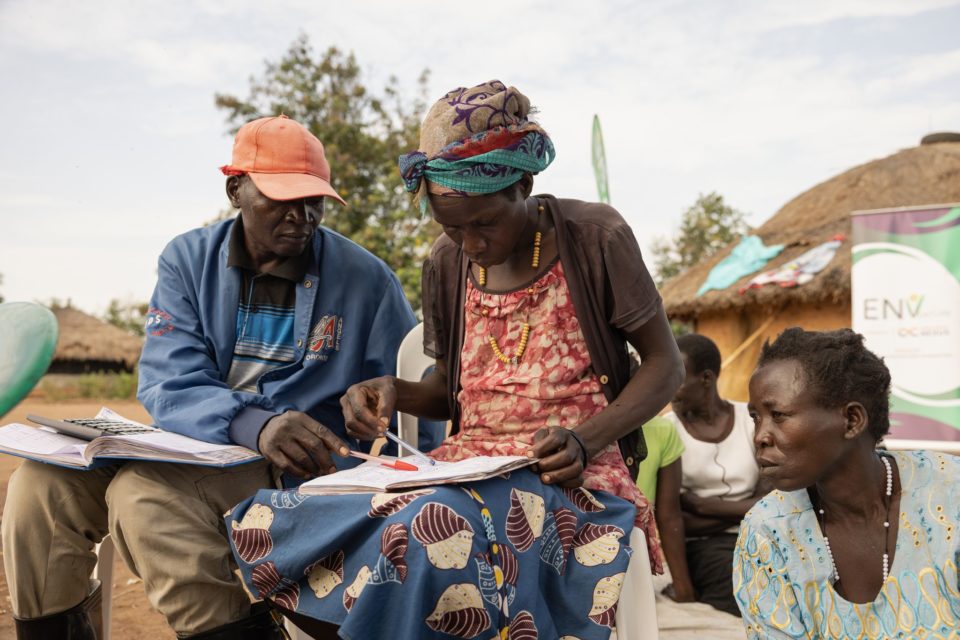
Our NEX Uganda program supports inspiring women who help local women & youth groups to distribute clean energy products in hard to reach areas.
New Energy Nexus needs to become stronger still in Southeast Asia, east and west African countries, as well as India and its neighbors. We need to support the clean energy innovation ecosystems of these countries. And we need to become good at training and supporting grass roots energy access entrepreneurs and those who are driving adoption.
Whereas there are three dozen clean energy incubators and accelerators and over 50 climate tech funds focused on the American market there are but a few in countries like Indonesia and Nigeria. These two nations as examples, may soon be larger than the USA by population and certainly in terms of energy demand growth, most of which is currently planned to come from fossils – coal in the case of Indonesia, diesel in Nigeria.
As part of getting good at innovation in the deployment of existing technologies, and scaling the support for entrepreneurs in emerging markets, New Energy Nexus needs to prioritize adoption over invention. As Jigar Shah, the leader of the US Department of Energy’s Loan Program Office likes to say, if a product is not at prototype yet it may not be much use in the climate fight.
We have little time left in the struggle to keep the world to a 1.5 degrees rise and the tools we have now are the ones we will most likely use in the time available. It does not mean new ideas are not welcome (not at all!). Entrepreneurs will need to succeed in bringing insights to market but the new, new thing may not be a technology per se, so much as a way to sell it or a finance product to spread it, or a software to integrate it better into existing infrastructure.
It is in wind and solar generation that we need ingenuity to be applied and where fortunes may be made. So much innovation is needed to improve energy storage technologies; grid forming and firming power electronics; battery management systems; as well as transmission and distribution. As just one example, New Energy Nexus surfaced a science project that alone could reduce the need for new mining of Lithium by 15% for the same volume of metal through yield engineering improvements in the crushing of spodumene ores in Australia, which contribute over 50% of the raw material. It is in the process flows, components, and circular economy that opportunities for innovation reside.
This is a shift for many of our entrepreneur support organizations, who are seeking unicorn founders with some hail Mary new tech, cut from whole cloth. If one comes along, great, we should back them. And we have specialty programming to surface such solutions in sustainable aviation fuel at Third Derivative or with gas displacement from kitchens in California at CalSEED, but the emphasis of our programs should be spreading the solutions that we’ve got. That will require ingenuity also on our part as well as the diverse entrepreneurs we seek to support. Our teams will go through their own innovation in program design and we expect more new ideas, like digital training for electricians to sell and install solar, to grow in our portfolio of activities.

Swap Energi’s swappable battery technology lets riders exchange used batteries, helping Indonesia accelerate it’s transition into a clean energy economy.
My last thought for this final stretch as we see the finishing line coming up in the 2030s is that this is our shot to get the economy right. Learning from the mistakes of the fossil fuel era, which lasted about 200 years, we should make sure the next couple of centuries are more just and equitable with less impacts on people and the planet.
The good news is this prospect is at hand in the architecture of distributed energy – the most economic way to build out our solar, wind and battery powered economy is not centralized – and in the nature of our recyclable technologies. All the pieces and parts could be used and recaptured at their end of life and used again – from PV cells to steel and fiberglass in wind turbines to the metals in modern batteries.
Achieving this and building businesses to run this circular economy that maximize benefits to public as well as private interests, with human rights and environmental justice as an outcome baked in from the outset, is the great promise of the energy transition.
New Energy Nexus’ job is to support the folks who will make this happen. We’re also going to build on our work to make access to funding more accessible around the world.
Whereas fossil fuels were necessarily developed at the expense of others, we can make our energy system the driving force of a more equitable and inclusive economy in just a decade or two. I can’t wait. Shine on!